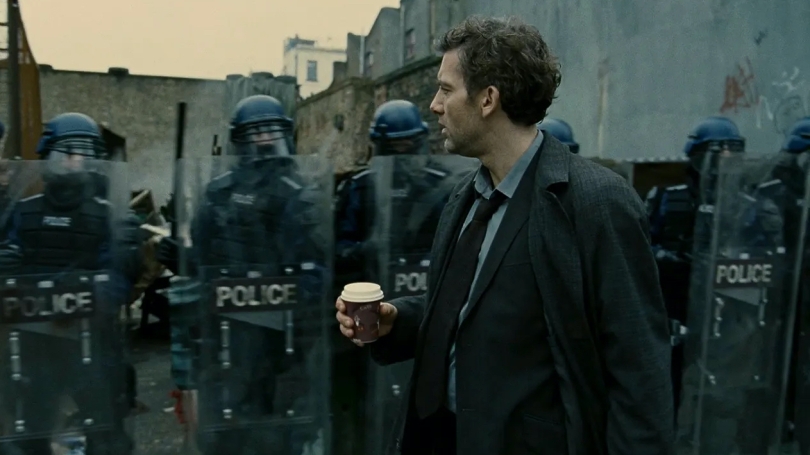
- About
- Departments & Programs
- Faculty Resources
- Governance
- Diversity
- News
Back to Top Nav
Back to Top Nav
Back to Top Nav
Back to Top Nav
The Feb 20–22 "Children of Cuarón" conference will explore how futuristic fiction illuminates the world's biggest challenges, as part of the Dialogue Project's special topic series on borders and immigration.
The year is 2027, global conflict has engulfed the planet, and humans face extinction following 18 years of infertility. The United Kingdom has become a totalitarian police state in which refugees are imprisoned, deported, or executed.
That's the premise of the 2006 dystopian thriller Children of Men, co-written and directed by Alfonso Cuarón and widely considered a science fiction and "cli-fi" ("climate fiction") cinema classic.
With its representation of the inhumane treatment and incarceration of immigrants, the film has also become "an indispensable part of the curriculum" in the Department of Latin American, Latino, and Caribbean Studies (LALACS), says professor and chair Desirée Garcia.
The film is the inspiration behind a three-day conference LALACS will host at Dartmouth this month as part of the Dialogue Project's special topic series on borders and immigration, Children of Cuarón: Speculative Futures Through Cinematic Fiction. The conference brings together filmmakers, creative writers, and scholars to explore how speculative fiction informs meaningful discussion about climate change, human displacement, and social conflict today and in the future.
"As we near 2027, the year in which Children of Men is set, we join other scholars, critics, and cultural producers in using the text to interpret the world around us," Garcia says. "As our title suggests, Cuarón and his film are the inspiration for this conference, but not the sole subject of it. Among us are contributors to speculative fiction, critics of Cuarón and Children of Men, as well as admirers of other authors and filmmakers whom, they would argue, inspire an equally important engagement with our collective past, present, and future."
Garcia organized the conference with several Dartmouth colleagues, including professors Mary Coffey, Marcela Di Blasi, and Matt Garcia, as well as American University film and literature scholar Jeffrey Romero Middents '93.
The conference will serve as a curricular component of several winter term LALACS courses, including Food History (taught by Mario Machado); Mexicanidad: Race/Raza, (trans)Nation, and Mexican(o/a/x) Cultural Identity (Mary Coffey); Speculative Pasts (Mario Machado); Making Video Essays (Desirée Garcia); Comparative Borderlands in the Americas (Jorge Cuellar); and Border Crossers (Matt Garcia).
Students, faculty, and staff are welcome to attend the conference, which kicks off on Thursday, Feb. 20, at 7 p.m. in Loew Auditorium with a screening of the 2008 sci-fi film Sleep Dealer and talk by its award-winning director, Alex Rivera. The film follows a Mexican gig worker wired into a cybernetwork to complete virtual work in the United States. Rivera received a MacArthur Foundation Award in 2021 in recognition of his film and media work, which focuses on migration, human rights, and the failure of immigration policies.
On Friday, Feb. 21, the conference continues with a panel discussion on borders at the Hayward Room of the Hanover Inn featuring visiting scholars Alex Aviña, Catherine Ramirez, and David Vazquez, filmmaker Alex Rivera, and writer Carmen Maria Machado, moderated by professor Matt Garcia.
At 4:30 on Saturday, Feb. 22, Coffey will lead a presentation of José Clemente Orozco's famed mural, The Epic of American Civilization. The monumental and prescient work explores the impact of nationalism and rapid industrialization. Located in the Orozco Room in Baker Library, the 24 panels comprising the mural cover nearly 3,200 square feet of wall space. Painted between 1932 and 1934, the mural was designated a national historic landmark in 2013.
"José Clemente Orozco reorients the 'epic of America' from the standard U.S. narrative that begins with British colonization along the northeastern seaboard and proceeds heroically west to a Mexican story rooted in Mesoamerican civilizations and the devastation wrought by the Spanish Conquest," Coffey wrote in the Hood Museum of Art's publication Orozco at Dartmouth. "Orozco presents America's epic as cyclical in nature, the eternal return of destruction and creation, rather than a linear tale of democratic expansion and progress."
Additional conference events, including a screening of Children of Men, are listed on the conference schedule.